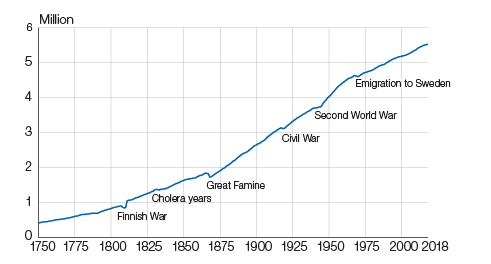News 13 Dec 2019
140 year-old statistical information trove describes a changing Finland
The roots of the Statistical Yearbook of Finland stretches back 140 years when Suomenmaan tilastollinen wuosikirja 1879 (Statistical yearbook of Finland) was published with authorisation from the Senate. The publication was a booklet that was slightly larger than a modern mobile phone and included 50 tables on the Finnish population and economy.
The newly published Statistical Yearbook of Finland 2019 is a comprehensive volume of statistics that describes society and its development in Finland in detail. In addition to the latest data, the yearbook contains long time series and regional data, as well as plenty of comparison data on other countries. The book is in Finnish, Swedish and English, and contains 591 pages and 616 tables.
Extracts from the Statistical Yearbook of Finland:
Development of population

- Finland’s population exceeded two million for the first time in 1879. Three million was exceeded in 1912, four million in 1950 and in 1991, the limit of five million was broken. At the end of 2018, Finland’s population was 5,517,919. According to the latest population projection, Finland’s population will continue growing until 2030.
- At the end of the 19th century, the natural population increase was on average 31,000 persons per year, and at the end of the 1940s more than 60,000 persons per year. The natural population increase refers to the difference between live births and deaths. Over the past three years, natural population increase has been negative: 6,950 more persons died that were born in 2018.
- In the 1950s dwellings were still small and cramped and their standard of equipment was low. More than 70 per cent of dwellings had no sewerage or running water. In 1950, as many as 57.3 per cent of dwellings had less than three rooms when the kitchen is included. In 2018, the share of small dwellings was 25.5 per cent of the dwelling stock.
- At the end of the 1980s, nearly one-third of the population lived alone. In thirty years, the number of one-person households has nearly doubled. In 2018, there were 2.7 million households of which 1.2 million were one-person households.
- In 2018, in total 30,365 persons completed the matriculation examination of whom some 58 per cent were women. In 1910, altogether 929 persons completed the matriculation examination and nearly 37 per cent of them were women. At the end of the 1970s, the share of women was at its highest, over 63 per cent.
- At the end of 2018 there were 3.5 million registered passenger cars in Finland. The oldest passenger cars still in the register have been taken into use already at the beginning of the 20th century. In 2018, there were 44 passenger cars that had been taken into use before the year 1921.
- Last year, the forest industry used 64.5 million cubic metres of domestic roundwood, more than ever before. In 1860, the forest industry used 1.2 million cubic metres of domestic roundwood and in 1950 the used volume was 20.1 million cubic metres.
- In 1970, Finland’s trade account was EUR 233 million in deficit. Since then, the trade account was at its best at around EUR 12.6 billion in surplus in 2000. In 2018, the deficit of the trade account was nearly EUR three 3 billion.
Source: Statistical Yearbook of Finland 2019. Statistics Finland. Price EUR 80 (incl. VAT).
The publication can be ordered from the customer service of Edita Publishing Oy throughout December +358 20 450 05 or from Edita's online store and starting from 2 January 2020 from the customer service of PunaMusta Oy +358 10 2308 365, verkkokauppa@punamusta.com.
The Yearbook can also be downloaded in PDF format at tilastokeskus.fi/vuosikirja2019
Further information: Planner Sirkku Hiltunen tel. +358 29 551 6373
